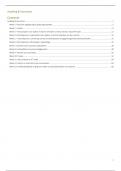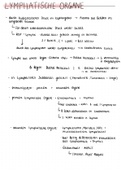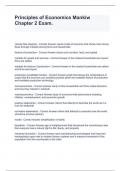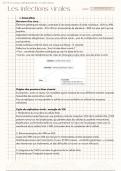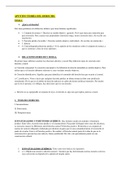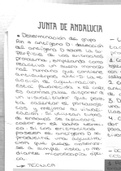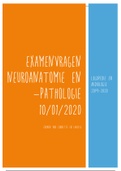HC1. Wat is stotteren?
1. Wat is vloeiendheid?
Definities
o Fluency
- the aspect of speech production that refers to the continuity, smoothness, rate and
effort with which phonologic, lexical, morphologic, and/or syntactic language units
are spoken. ASHA guidelines (1999)
o Vloeiende spraak
- Het praten verloopt met een zekere snelheid (rate)
- De klanken volgen elkaar vloeiend op (continuity)
- Er is een normaal ritme in de spraak (rhythm)
- De spreker ervaart relatief weinig inspanning (effort)
Starkweather (1984)
o Vloeiende sprekers
- Diegenen die zonder merkbare inspanning lange reeksen van syllaben kunnen
produceren, door een adequate combinatie van snelheid en continuiteit
(Starkweather & Givens-Ackerman, 1997)
Vloeiend, normaal niet vloeiend, stotteren
o Spraakvloeiendheid = vloeiende motorische spraakproductie
o Taalvloeiendheid = m.b.t. woordvinding en zinsformulering
- Semantische vloeiendheid = vlotheid waarmee men woorden kan oproepen uit een
pool van lexicale items
- Syntactische vloeiendheid = vlotheid waarmee sprekers complexe zinnen opbouwen
die linguïstisch complexe structuren bevatten
- Pragmatische vloeiendheid = vlotheid waarmee men kent en kan uitvoeren wat men
wil zeggen in reactie op een gamma van situatieve
elementen
- Fonologische vloeiendheid = het gemak waarmee men binnen betekenisvolle en
complexe taalunits lange en complexe klankketens kan
produceren
o Personen die stotteren (PDS) kunnen stotteren maar tegelijk talig wél vloeiend zijn
o Vloeiendheid is afwijkend
- Wanneer de inspanning voor planning en uitvoering overmatig is
- Wanneer onvloeiendheden optreden aan een frequentie en/of in een mate die niet
past bij de leeftijd van de spreker
- Wanneer het spreekritme atypisch is of van die aard dat het de spraakproductie
belemmert of verstoort.
- Ham (1990)
,Uitdagingen:
o Wanneer wordt afwijkende vloeiendheid abnormaal?
o Vanaf welke mate van afwijkende vloeiendheid kunnen we spreken over stotteren?
o Kunnen we een kind diagnosticeren als “stotterend”, gegeven het feit dat onvloeiendheid
een verwacht en relatief normaal onderdeel vormt van de spraak- en taalverwerving?
DP: blokkeringen & herhalingen &
verlengingen
SLD: ook iets wat bij niet stotteraars gebeurt
Stotters = stuttering-like disfluencies = within-word
Geen stotters = other disfluencies = between-word
,Vloeiend, normaal niet vloeiend, stotteren
o Kinderen die niet stotteren:
- op peuter-kleuterleeftijd gem. 6-8 onvloeiendheden (alle types)/100 syllaben.
Volwassenen die niet stotteren:
- gem. 5%.
Geen groot verschil tussen kinderen en volwassenen
Kinderen die stotteren:
- op peuter-kleuterleeftijd: gem. 17 onvloeiendheden/100 syllaben
o Hogere percentages (19-20%) werden gevonden dichter bij de aanvang (“onset”) van het
stotteren
o Met stijgende leeftijd
- afname van het aantal woordherhalingen, stille pauzes en zinsrevisies
- toename van het aantal opgevulde pauzes (tussenvoegsels)
o Ongeacht leeftijd: KDS meer stuttering-like disfluencies dan KDNS
o Als groep produceren jonge KDS min. 3 à 4 SLD /100 syllaben, terwijl KDNS minder dan 3%
o Proportioneel tegenover het totale aantal onvloeiendheden is het % SLD bij KDNS steeds
<50% en meestal rond 35% (Yairi, 1997)
o Bij KDS maken de SLD gemiddeld voor 65% deel uit van het totale aantal onvloeiendheden;
dus bijna het dubbel van de KDNS (Ambrose & Yairi, 1999)
o Ten minste 3 SLD/ 100 syllaben = KDS of “at risk” voor stotteren
- Ook nog andere criteria voor stotteren
o Hoe hoger de proportie SLD tegenover het totale aantal spraakonvloeiendheden, hoe
groter de kans dat luisteraars het kind zullen beoordelen als stotterend.
2. Wat is stotteren?
Definitie:
o Childhood-onset fluency disorder
- a communication disorder characterized by a disturbance in the flow and timing of
speech that is inappropriate for an individual’s age.
- Also referred to as stuttering, this condition includes the repetition or prolongation
of speech sounds, hesitations before and during speaking, long pauses in speech,
effortful speech, and/or monosyllabic whole-word repetitions.
- This condition is typically accompanied by anxiety about speaking and can place
limitations on how comfortable a child feels participating in social or academic
environments.
- Symptoms of childhood-onset fluency disorder develop between the ages of 2 and 7,
with 80 to 90 percent of cases developing by age 6.
- While mild stuttering is common in children who are learning to speak, this behavior
becomes a fluency disorder when it persists over time and causes distress in the
child.
- Stuttering is more commonly found among males than females.
, - Symptoms:
Repetition of syllables, sounds, or monosyllabic words
Prolonging the vocalization of consonants and vowels
Broken words blokkeringen (e.g., pauses within a word)
Filled or unfilled pauses in speech
Word substitution to avoid problematic words
Words produced with an excess of physical tension (e.g., head jerking, fist
clenching)
Frustration or embarrassment related to speech
Geïntegreerde visie:
ICF:
KERNgedrag (overte/ zichtbare verschijnselen)
Klank-en syllabeherhalingen:
o Ongewilde herhalingen van een klank (vaak de eerste) of syllabe van een woord.
o Vaak nogal snel en/of onregelmatig.
o Doorgaans met extra spierspanning.
o Soms gebeurt hetzelfde met eenlettergrepige woorden.
o Bv. “Wa-wa-wacht nu maar”, “en en en en…”
Klankverlengingen:
o Het ongewild verlengen van een klank in een woord; vaak de beginklank maar niet altijd.
o Doorgaans met extra spierspanning.
o Bv. “Mmmmmmmmag ik?”
Blokkades:
o Een ongewilde afsluiting door overmatige spierspanning t.h.v. de glottis, tong of lippen. Er is
dan even geen klank. Bv. ”(I)……….ik”
1. Wat is vloeiendheid?
Definities
o Fluency
- the aspect of speech production that refers to the continuity, smoothness, rate and
effort with which phonologic, lexical, morphologic, and/or syntactic language units
are spoken. ASHA guidelines (1999)
o Vloeiende spraak
- Het praten verloopt met een zekere snelheid (rate)
- De klanken volgen elkaar vloeiend op (continuity)
- Er is een normaal ritme in de spraak (rhythm)
- De spreker ervaart relatief weinig inspanning (effort)
Starkweather (1984)
o Vloeiende sprekers
- Diegenen die zonder merkbare inspanning lange reeksen van syllaben kunnen
produceren, door een adequate combinatie van snelheid en continuiteit
(Starkweather & Givens-Ackerman, 1997)
Vloeiend, normaal niet vloeiend, stotteren
o Spraakvloeiendheid = vloeiende motorische spraakproductie
o Taalvloeiendheid = m.b.t. woordvinding en zinsformulering
- Semantische vloeiendheid = vlotheid waarmee men woorden kan oproepen uit een
pool van lexicale items
- Syntactische vloeiendheid = vlotheid waarmee sprekers complexe zinnen opbouwen
die linguïstisch complexe structuren bevatten
- Pragmatische vloeiendheid = vlotheid waarmee men kent en kan uitvoeren wat men
wil zeggen in reactie op een gamma van situatieve
elementen
- Fonologische vloeiendheid = het gemak waarmee men binnen betekenisvolle en
complexe taalunits lange en complexe klankketens kan
produceren
o Personen die stotteren (PDS) kunnen stotteren maar tegelijk talig wél vloeiend zijn
o Vloeiendheid is afwijkend
- Wanneer de inspanning voor planning en uitvoering overmatig is
- Wanneer onvloeiendheden optreden aan een frequentie en/of in een mate die niet
past bij de leeftijd van de spreker
- Wanneer het spreekritme atypisch is of van die aard dat het de spraakproductie
belemmert of verstoort.
- Ham (1990)
,Uitdagingen:
o Wanneer wordt afwijkende vloeiendheid abnormaal?
o Vanaf welke mate van afwijkende vloeiendheid kunnen we spreken over stotteren?
o Kunnen we een kind diagnosticeren als “stotterend”, gegeven het feit dat onvloeiendheid
een verwacht en relatief normaal onderdeel vormt van de spraak- en taalverwerving?
DP: blokkeringen & herhalingen &
verlengingen
SLD: ook iets wat bij niet stotteraars gebeurt
Stotters = stuttering-like disfluencies = within-word
Geen stotters = other disfluencies = between-word
,Vloeiend, normaal niet vloeiend, stotteren
o Kinderen die niet stotteren:
- op peuter-kleuterleeftijd gem. 6-8 onvloeiendheden (alle types)/100 syllaben.
Volwassenen die niet stotteren:
- gem. 5%.
Geen groot verschil tussen kinderen en volwassenen
Kinderen die stotteren:
- op peuter-kleuterleeftijd: gem. 17 onvloeiendheden/100 syllaben
o Hogere percentages (19-20%) werden gevonden dichter bij de aanvang (“onset”) van het
stotteren
o Met stijgende leeftijd
- afname van het aantal woordherhalingen, stille pauzes en zinsrevisies
- toename van het aantal opgevulde pauzes (tussenvoegsels)
o Ongeacht leeftijd: KDS meer stuttering-like disfluencies dan KDNS
o Als groep produceren jonge KDS min. 3 à 4 SLD /100 syllaben, terwijl KDNS minder dan 3%
o Proportioneel tegenover het totale aantal onvloeiendheden is het % SLD bij KDNS steeds
<50% en meestal rond 35% (Yairi, 1997)
o Bij KDS maken de SLD gemiddeld voor 65% deel uit van het totale aantal onvloeiendheden;
dus bijna het dubbel van de KDNS (Ambrose & Yairi, 1999)
o Ten minste 3 SLD/ 100 syllaben = KDS of “at risk” voor stotteren
- Ook nog andere criteria voor stotteren
o Hoe hoger de proportie SLD tegenover het totale aantal spraakonvloeiendheden, hoe
groter de kans dat luisteraars het kind zullen beoordelen als stotterend.
2. Wat is stotteren?
Definitie:
o Childhood-onset fluency disorder
- a communication disorder characterized by a disturbance in the flow and timing of
speech that is inappropriate for an individual’s age.
- Also referred to as stuttering, this condition includes the repetition or prolongation
of speech sounds, hesitations before and during speaking, long pauses in speech,
effortful speech, and/or monosyllabic whole-word repetitions.
- This condition is typically accompanied by anxiety about speaking and can place
limitations on how comfortable a child feels participating in social or academic
environments.
- Symptoms of childhood-onset fluency disorder develop between the ages of 2 and 7,
with 80 to 90 percent of cases developing by age 6.
- While mild stuttering is common in children who are learning to speak, this behavior
becomes a fluency disorder when it persists over time and causes distress in the
child.
- Stuttering is more commonly found among males than females.
, - Symptoms:
Repetition of syllables, sounds, or monosyllabic words
Prolonging the vocalization of consonants and vowels
Broken words blokkeringen (e.g., pauses within a word)
Filled or unfilled pauses in speech
Word substitution to avoid problematic words
Words produced with an excess of physical tension (e.g., head jerking, fist
clenching)
Frustration or embarrassment related to speech
Geïntegreerde visie:
ICF:
KERNgedrag (overte/ zichtbare verschijnselen)
Klank-en syllabeherhalingen:
o Ongewilde herhalingen van een klank (vaak de eerste) of syllabe van een woord.
o Vaak nogal snel en/of onregelmatig.
o Doorgaans met extra spierspanning.
o Soms gebeurt hetzelfde met eenlettergrepige woorden.
o Bv. “Wa-wa-wacht nu maar”, “en en en en…”
Klankverlengingen:
o Het ongewild verlengen van een klank in een woord; vaak de beginklank maar niet altijd.
o Doorgaans met extra spierspanning.
o Bv. “Mmmmmmmmag ik?”
Blokkades:
o Een ongewilde afsluiting door overmatige spierspanning t.h.v. de glottis, tong of lippen. Er is
dan even geen klank. Bv. ”(I)……….ik”


